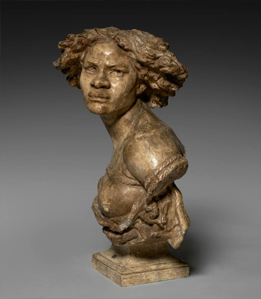April 18, 2022: Recent acquisitions by the Cleveland Museum of Art (CMA) include a masterpiece by Jean-Baptiste Carpeaux, the foremost French sculptor of the Second Empire (1852-1870); a landscape drawing by Netherlandish artist Hans Bol; and a Taihu stone presented to the museum by contemporary Chinese artist Liu Dan.
 Jean-Baptiste Carpeaux’s Why Born Enslaved!
Jean-Baptiste Carpeaux’s Why Born Enslaved!
The CMA acquires the original plaster model of celebrated 19th-century sculpture
Why Born Enslaved! is one of Jean-Baptiste Carpeaux’s most iconic, signature works. It depicts a bound African woman looking defiantly upward. The sculpture’s original, polychromed surface is covered with complex, nuanced hatchings and subtle modeling that enhance the expressive power of the figure. While there are other versions of the sculpture in museum collections in the United States and Europe, scrapings and marks on the surface of the plaster indicate the work the CMA has acquired is the master model from which the other versions were produced.
The figure in Why Born Enslaved! is depicted in a series of explosive forms and dramatic silhouettes. Her expression, movement and surface seem to palpitate with life. Although slavery had been abolished in France since 1848, it remained a contested issue in Carpeaux’s lifetime as France was expanding its colonies into north Africa where the practice continued. The American Civil War provided fresh inspiration to abolitionists. The vigor of the figure’s twisting form and the intensity of her gaze underscore the gravity of the subject and the intensity of abolitionist sentiment of the period.
Why Born Enslaved! will have enormous impact on the CMA’s collection due to its powerful aesthetic qualities, its formidable stance on one of the most pressing social and political issues of the 19th century and the relevance of its subject today. There is only one other known version with a similar polychromed surface, a half size reduction at the Brooklyn Museum.
Why Born Enslaved! will allow the CMA to host complex conversations through artworks that provoke painful histories and challenge conventional historical narratives. When the sculpture goes on view later this spring, it will feature an interpretive framework that considers the unnamed sitter, what she represented when the bust was created and her relevance now. By highlighting her place in a global lineage of colonial images of Black women, as well as in the contemporary scholarship and museum practice that seeks to name or otherwise identify sitters like her, the model’s status as both living person and allegorical figure will allow viewers to reckon with the power imbalances that existed even in the creation of abolitionist art.
Why Born Enslaved!, 1868. Jean-Baptiste Carpeaux (French, 1827-1875). Plaster, original polychromed surface; h. 67 cm (26-1/2 in.)

